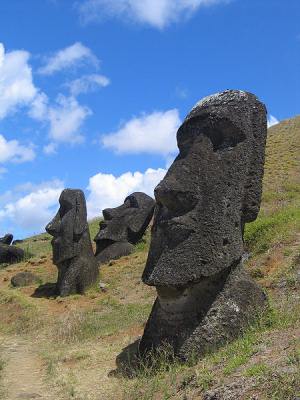Collapse and the Limits of Consumption
Robin Whitlock asks if studies of the decline of societies such as that of Easter Island can shed light on contemporary concerns.

Last September Jared Diamond’s celebrated book Collapse: How Societies Choose To Fail Or Succeed, first published in 2005, was criticised by the environmentalist Mark Lynas, who drew on the work of two scholars investigating the archaeological record on Easter Island.
In Collapse Diamond argues that Easter Island society, famous for its construction of giant Moai statues, was brought down through de-forestation, as its inhabitants used ever more wood to transport the stones of which the Moai were made. Lynas, however, cites The Statues That Walked, a study, published last year by Terry Hunt and Carl Lipo, two archaeologists who have re-examined the evidence on Easter Island and concluded that, at least as far as the Pacific island is concerned, Diamond’s argument does not stand up. They claim that its deforestation was not caused by man directly but by a plague of rats eating seeds and thus denuding the island’s tree cover.
Whether or not Diamond’s thesis is correct the debate raises questions about the collapse of ancient societies and its relevance to current concerns. It has become a fertile area of research, one on which a number of scholars offer intriguing insights.
Joseph Tainter is an anthropologist, currently a professor in the Department of Environment and Society at Utah State University. In The Collapse of Complex Societies (1988) he argues that, as societies become more complex, they need to invest ever greater organisational and physical energy in order to maintain those levels of complexity. This process advances up to a point where the energy used depletes the material resources needed to sustain them and eventually they collapse. Tainter cites the examples of the Roman Empire and the Mayan and Chaco Canyon civilisations of Mesoamerica. During such a collapse a society is forced to shed significant levels of complexity, reverting to earlier patterns of simplicity and sustainability in a battle to survive. It is a struggle that a society will always eventually lose.
In their study Population Crises and Population Cycles (1999) W.M.S. and Claire Russell (1999) also argue that ancient cities effectively ‘stand in deserts of their own making’. Like Tainter, the Russells examine over-population and argue that developments in innovation and technology lead to population increases, which subsequently lead to more problems and increased demand for innovative solutions. The Russells cite the example of Mesopotamia (Sumer), where irrigated agricultural lands were ruined by salt. This was the result of over-irrigation, caused by the need to serve an expanding population. The irrigation raised the water table which brought salts into the surface soil, thus making it infertile. As a result, between 2100 and 1700 bc the Sumerian population declined by nearly three fifths, despite the cultivation of more salt-tolerant barley.
Thomas Homer-Dixon, in his book The Upside of Down: Catastrophe, Creativity and the Renewal of Civilization (2006), draws parallels between ancient societies, particularly that of the Roman Empire, and our own. He argues that various pressures, including energy stress, environmental stress and climate change, can in conjunction present a lethal threat to the continued comfortable status of a civilised society.
Perhaps most convincing of all, a 2004 paper by Marco Janssen and Marten Scheffer argues that decisions in advanced societies are often based on the amounts of energy and resources that have been invested in the development of that society at earlier stages in its history rather than on likely future returns, which may or may not determine its future welfare and survival. This is something they term a ‘sunk cost effect’. This can be defined as an unwillingness to abandon a particular course, if a great deal has been invested in it (a ‘sunk cost’) due to the losses that will be incurred as a result. This reluctance to abandon something often prevails no matter how dim the prospects of future success.
Neither Diamond nor his opponents have to be right about the collapse of the society on Easter Island in order for us to draw parallels between ancient societies and our own. Ours is a society obsessed with exponential economic growth (a pattern of growth dependent on an ever increasing rate of production irrespective of the fact that we live on a planet with finite resources). And this when sustainable development, which takes accounts of natural resources, would seem to make more sense and which, like the ancient societies discussed here, continually thinks big despite the drain on resources and the environment. Such situations have been faced by societies in the past and our refusal to learn from their mistakes imperils our own future.